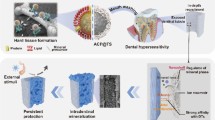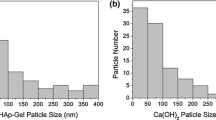Summary
Bone and teeth are derived from intrafibrillarly mineralized collagen fibrils as the second level of hierarchy. According to polymer-induced liquid-precursor process, using amorphous calcium phosphate precursor (ACP) is able to achieve intrafibrillar mineralization in the case of bone biomineral in vitro. Therefore, ACP precursors might be blended with any osteoconductive scaffold as a promising bone formation supplement for in-situ remineralization of collagens in bone. In this study, mesoporous silica nanoparticles with carboxyl-functionalized groups and ultra large-pores have been synthesized and used for the delivery of liquid like biomimetic precursors (ACP). The precursor delivery capacity of the nanoparticles was verified by the precursor release profile and successful mineralization of 2D and 3D collagen models. The nanoparticles could be completely degraded in 60 days and exhibited good biocompatibility as well. The successful translational strategy for biomineralization precursors showed that biomineralization precursor laden ultra large pore mesoporous silica possessed the potential as a versatile supplement in demineralized bone formation through the induction of intrafibrillar collagen mineralization.
Similar content being viewed by others
References
Ferreira AM, Gentile P, Chiono V, et al. Collagen for bone tissue regeneration. Acta Biomate, 2018(9):3191–3200
Weiner S, Wagner HD. The material bone: structure-mechanical function relations. Annu Rev Mater Sci, 1998,28(1):271–298
Olszta MJ, Cheng X, Jee SS, et al. Bone structure and formation: A new perspective. Mat Sci Eng R, 2007,58(3–5):77–116
Jiao K, Niu LN, Ma CF, et al. Collagen Mineralization: Complementarity and Uncertainty in Intrafibrillar Mineralization of Collagen. Adv Funct Mater, 2016,26(38):6850–6850
Nudelman F, Pieterse K, George A, et al. The role of collagen in bone apatite formation in the presence of hydroxyapatite nucleation inhibitors. Nat Mater, 2010,9(12):1004
Liu Y, Luo D, Wang T. Hierarchical structures of bone and bioinspired bone tissue engineering. Small, 2016,12(34):4611–4632
Mahamid J, Sharir A, Addadi L, et al. Amorphous calcium phosphate is a major component of the forming fin bones of zebrafish: Indications for an amorphous precursor phase. P Natl Acad Sci USA, 2008,105(35):12 748–12 753
Shields LB, Raque GH, Glassman SD, et al. Adverse effects associated with high-dose recombinant human bone morphogenetic protein-2 use in anterior cervical spine fusion. Spine (Phila Pa 1976), 2006,31(5):542–547
Liu Y, Liu S, Luo D, et al. Hierarchically staggered nanostructure of mineralized collagen as a bone-grafting scaffold. Adv Mater, 2016,28(39):8740–8748
Luo XJ, Yang HY, Niu LN, et al. Translation of a solution-based biomineralization concept into a carrier-based delivery system via the use of expanded-pore mesoporous silica. Acta Biomater, 2016,31:378–387
Zhang W, Luo XJ, Niu LN, et al. Biomimetic intrafibrillar mineralization of type I collagen with intermediate precursors-loaded mesoporous carriers. Sci Rep, 2015,5:11 199
Tang FQ, Li LL, Chen D. Mesoporous silica nanoparticles: synthesis, biocompatibility and drug delivery. Adv Mater, 2012,24(12):1504–1534
Yang YN, Yu CZ. Advances in silica based nanoparticles for targeted cancer therapy. Nanomed Nanotechnol Biol Med, 2016,12(2):317–332
Dai CL, Guo H, Lu JX, et al. Osteogenic evaluation of calcium/magnesium-doped mesoporous silica scaffold with incorporation of rhBMP-2 by synchrotron radiation-based µCT. Biomaterials, 2011,32(33):8506–8517
Knežević NŽ, Durand JO. Large pore mesoporous silica nanomaterials for application in delivery of biomolecules. Nanoscale, 2015,7(6):2199–2209
Mizutani M, Yamada Y, Yano K. Pore-expansion of monodisperse mesoporous silica spheres by a novel surfactant exchange method. Chem Commun, 2007, (11):1172–1174
Slowing II, Wu CW, Vivero Escoto JL, et al. Mesoporous silica nanoparticles for reducing hemolytic activity towards mammalian red blood cells. Small, 2009,5(1):57–62
Yang Q, Wang SC, Fan PW, et al. pH-responsive carrier system based on carboxylic acid modified mesoporous silica and polyelectrolyte for drug delivery. Chem Mater, 2005,17(24):5999–6003
Kim MH, Na HK, Kim YK, et al. Facile synthesis of monodispersed mesoporous silica nanoparticles with ultralarge pores and their application in gene delivery. ACS Nano, 2011,5(5):3568–3576
Muhammad F, Guo MY, Qi WX, et al. pH-triggered controlled drug release from mesoporous silica nanoparticles via intracelluar dissolution of ZnO nanolids. J Am Chem Soc, 2011,133(23):8778–8781
Luo Z, Cai KY, Hu Y, et al. Mesoporous silica nanoparticles end-capped with collagen: redox-responsive nanoreservoirs for targeted drug delivery. Angew Chem Int Ed, 2011,50(3):640–643
Bahadur NM, Furusawa T, Sato M, et al. Fast and facile synthesis of silica coated silver nanoparticles by microwave irradiation. J Colloid Interface Sci, 2011,355(2):312–320
An Y, Chen M, Xue Q, et al. Preparation and self-assembly of carboxylic acid-functionalized silica. J Colloid Interface Sci, 2007,311(2):507–513
Manzano M, Aina V, Arean C, et al. Studies on MCM-41 mesoporous silica for drug delivery: effect of particle morphology and amine functionalization. Chem Eng J, 2008,137(1):30–37
Mouslmani M, Rosenholm JM, Prabhakar N, et al. Curcumin associated poly (allylamine hydrochloride)-phosphate self-assembled hierarchically ordered nanocapsules: size dependent investigation on release and DPPH scavenging activity of curcumin. RSC Advances, 2015,5(24):18 740–18 750
Niu LN, Jee SE, Jiao K, et al. Collagen intrafibrillar mineralization as a result of the balance between osmotic equilibrium and electroneutrality. Nat Mater, 2017,16(3):370
Zhang YZ, Zhi ZZ, Jiang TY, et al. Spherical mesoporous silica nanoparticles for loading and release of the poorly water-soluble drug telmisartan. J Control Release, 2010,145(3):257–263
Zhang Q, Wang X, Li PZ, et al. Biocompatible, uniform, and redispersible mesoporous silica nanoparticles for cancer-targeted drug delivery in vivo. Adv Funct Mater, 2014,24(17):2450–2461
Lin YS, Haynes CL. Impacts of mesoporous silica nanoparticle size, pore ordering, and pore integrity on hemolytic activity. J Am Chem Soc, 2010,132(13):4834–4842
Hudson SP, Padera RF, Langer R, et al. The biocompatibility of mesoporous silicates. Biomaterials, 2008,29(30):4045–4055
Yang K, Ma YQ. Computer simulation of the translocation of nanoparticles with different shapes across a lipid bilayer. Nat Nanotechnol, 2010,5(8):579
Zhao Y, Sun X, Zhang G, et al. Interaction of mesoporous silica nanoparticles with human red blood cell membranes: size and surface effects. ACS Nano, 2011,5(2):1366–1375
Souris JS, Lee CH, Cheng SH, et al. Surface chargemediated rapid hepatobiliary excretion of mesoporous silica nanoparticles. Biomaterials, 2010,31(21):5564–5574
Chang BS, Guo J, Liu CY, et al. Surface functionalization of magnetic mesoporous silica nanoparticles for controlled drug release. J Mater Chem, 2010,20(44):9941–9947
Zhou XJ, Feng W, Qiu KX, et al. BMP-2 derived peptide and dexamethasone incorporated mesoporous silica nanoparticles for enhanced osteogenic differentiation of bone mesenchymal stem cells. ACS Appli Mater Inter, 2015,7(29):15 777–15 789
Fuchs AK, Syrovets T, Haas KA, et al. Carboxyl-and amino-functionalized polystyrene nanoparticles differentially affect the polarization profile of M1 and M2 macrophage subsets. Biomaterials, 2016,85:78–87
Zhou MY, Du X, Li WK, et al. One-pot synthesis of redox-triggered biodegradable hybrid nanocapsules with a disulfide-bridged silsesquioxane framework for promising drug delivery. J Mater Chem B, 2017,5(23):4455–4469
Croissant JG, Fatieiev Y, Khashab NM. Degradability and clearance of silicon, organosilica, silsesquioxane, silica mixed oxide, and mesoporous silica nanoparticles. Adv Mater, 2017,29(9):1604 634
Shadjou N, Hasanzadeh M. Bone tissue engineering using silica-based mesoporous nanobiomaterials: Recent progress. Mater Sci Eng C, 2015,55:401–409
Möller K, Bein T. Talented mesoporous silica nanoparticles. Chem Mater, 2016,29(1):371–388
Godin B, Gu J, Serda RE, et al. Tailoring the degradation kinetics of mesoporous silicon structures through PEGylation. J Biomed Mater Research A, 2010,94(4):1236–1243
Yang HY, Niu LN, Sun JL, et al. Biodegradable mesoporous delivery system for biomineralization precursors. Int J Nanomed, 2017,12:839
Wingender B, Bradley P, Saxena N, et al. Biomimetic organization of collagen matrices to template bone-like microstructures. Matrix Biol, 2016,52:384–396
Author information
Authors and Affiliations
Corresponding authors
Additional information
Conflict of Interest Statement
The authors declare no conflict of interest.
This study was financially supported by the National Natural Science Foundation of China (No. 81600911).
Rights and permissions
About this article
Cite this article
Wei, S., Wu, H. & Luo, Xj. Biomineralization Precursor Carrier System Based on Carboxyl-Functionalized Large Pore Mesoporous Silica Nanoparticles. CURR MED SCI 40, 155–167 (2020). https://doi.org/10.1007/s11596-020-2159-3
Received:
Revised:
Published:
Issue Date:
DOI: https://doi.org/10.1007/s11596-020-2159-3




